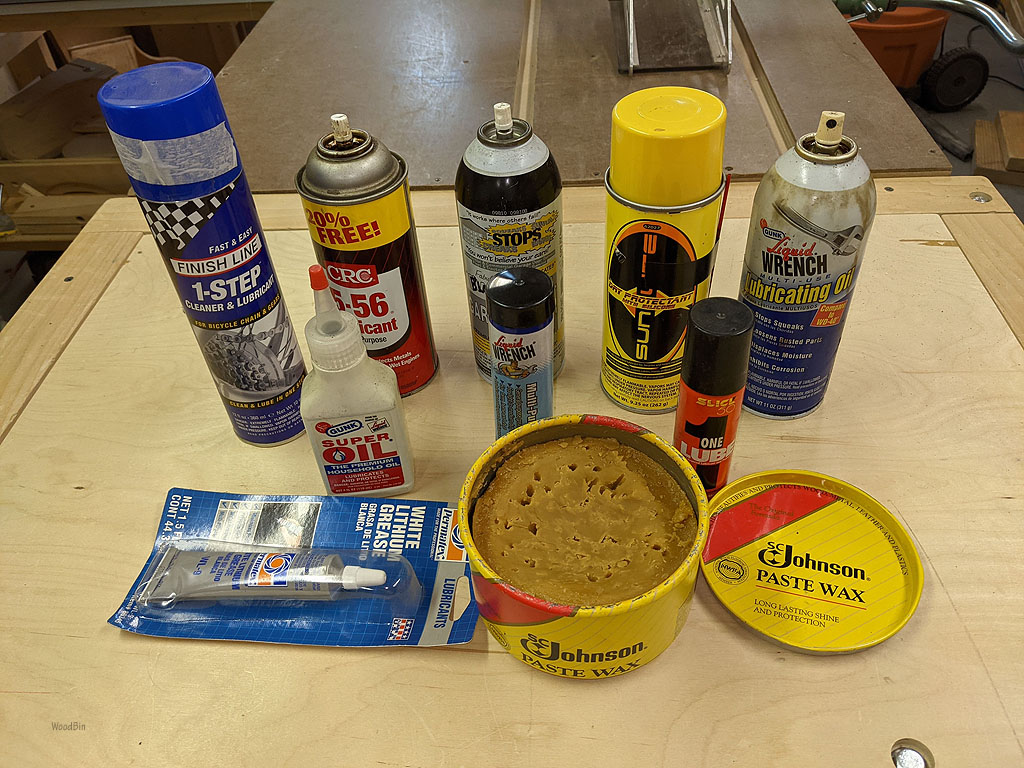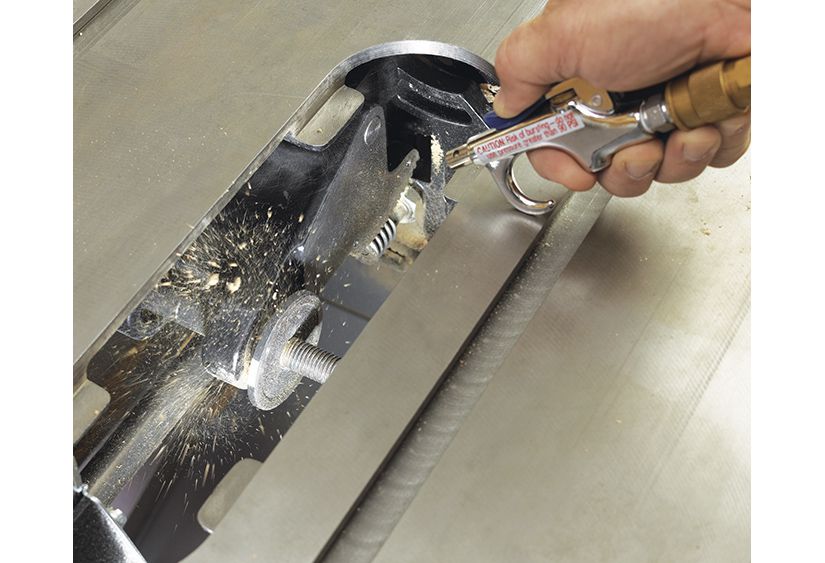Are you wondering what lube to use for your table saw? Look no further! In this article, we’ll explore the best lubricants for table saws and help you keep your tool running smoothly. So, let’s dive in and find the perfect lube for your table saw!
When it comes to maintaining your table saw, using the right lubricant is crucial. The right lube not only prevents rust and corrosion but also ensures smooth operation and extends the lifespan of your tool. But with so many options available, it can be overwhelming to choose the right one. Don’t worry, we’ve got you covered!
In this guide, we’ll walk you through different types of lubricants, their benefits, and how to apply them to your table saw. Whether you have a portable job site saw or a heavy-duty cabinet saw, we’ll help you find the perfect lube that suits your needs. Let’s get started and keep your table saw running like a well-oiled machine!

What Lube is Best for Your Table Saw?
Table saws are essential tools for any woodworker or DIY enthusiast. To ensure smooth operation and extend the lifespan of your table saw, proper lubrication is crucial. But with so many options available, how do you know which lube is best for your table saw? In this article, we’ll explore different types of lubes and their benefits, guiding you towards making the right choice for your table saw.
Types of Lubricants for Table Saws
When it comes to lubricating your table saw, you have several options to choose from. Each type of lubricant has its advantages and ideal usage scenarios. Let’s take a closer look at some of the most commonly used lubes for table saws.
1. Silicone-based Lubricants
Silicone-based lubricants are popular choices for table saws due to their versatility and ability to withstand high temperatures. They provide excellent lubrication, reducing friction and preventing rust and corrosion. Silicone lubes are also resistant to water and can be applied to both metal and plastic components of your table saw.
When using silicone-based lubricants, it’s essential to clean the surface thoroughly before application. This ensures that the lube adheres properly and doesn’t attract sawdust or debris, which can cause clogs or affect the saw’s performance.
Some popular brands of silicone-based lubricants for table saws include WD-40 Specialist Silicone Lubricant and Boeshield T-9.
2. Dry Lubricants
Dry lubricants, often in the form of spray or powder, are ideal for table saws as they leave no residue behind. They are typically made from graphite or molybdenum disulfide and provide excellent lubrication without attracting dust or debris.
Dry lubricants are easy to apply and suitable for both metal and plastic components. They are particularly useful for reducing friction on moving parts such as the miter gauge, fence, and blade height adjustment mechanism.
Popular dry lubricants for table saws include Blaster Dry Lube, Slipit Slideway, and White Lightning Clean Ride.
3. Aerosol Lubricants
Aerosol lubricants are convenient and easy to apply to table saws. They come in spray form and typically contain a mix of lubricants and rust inhibitors. These lubricants penetrate into hard-to-reach areas and provide a protective coating, preventing rust and corrosion.
When using aerosol lubricants, it’s essential to apply them in a well-ventilated area and avoid spraying directly onto the motor or electrical components of your table saw. Always follow the manufacturer’s instructions for best results.
Some popular aerosol lubricants for table saws include CRC Power Lube Industrial High-Performance Lubricant and 3-IN-ONE Professional Garage Door Lubricant.
4. White Lithium Grease
White lithium grease is a heavy-duty lubricant that provides excellent lubrication and long-lasting protection against rust and corrosion. It is particularly suitable for heavy-duty table saws and parts that require extra durability and lubrication.
White lithium grease is easy to apply, and a little goes a long way. It is commonly used on gears, bearings, and other heavily loaded parts of the table saw. However, it’s important to note that white lithium grease can attract dust and debris, so regular cleaning is essential.
Popular brands of white lithium grease include Lucas Oil White Lithium Grease and Super Lube Synthetic Grease.
5. Vegetable-based Lubricants
For those looking for a more eco-friendly and biodegradable option, vegetable-based lubricants are a great choice. These lubricants are made from renewable resources and are free from harmful chemicals.
Vegetable-based lubricants offer good lubrication properties and are safe to use on metal and plastic components. They are also non-toxic and odorless, making them suitable for environments where fumes or odors are a concern.
Brands that offer vegetable-based lubes for table saws include B’Laster Vegetable Based Lubricant and Sprayon LU104 Food Grade Lubricant.
# Cleaner and Rust Inhibitors for Table Saws
How to Choose the Right Lube for Your Table Saw
With so many options available, choosing the right lube for your table saw can be overwhelming. Consider the following factors to make an informed decision:
1. Application
Consider where you’ll be applying the lube on your table saw. Some lubes are meant for specific parts, such as gears or bearings, while others can be applied to various surfaces. Ensure the lube you choose matches your specific requirements.
2. Temperature Tolerance
If your table saw operates in extreme temperatures or near heat sources, opt for lubes that can withstand high heat without breaking down or evaporating. Check the manufacturer’s recommendations to ensure the lube is suitable for your operating conditions.
3. Compatibility
Not all lubes are compatible with every material. Ensure the lube you choose is safe to use on the metal or plastic components of your table saw. Check the manufacturer’s specifications for compatibility information.
4. Ease of Application
Consider how easy it is to apply and maintain the lube. Spray lubes are convenient for reaching tight spaces, while grease or oil may require more care during application and cleaning.
5. Longevity
If you’re looking for long-lasting protection, choose a lube that provides lasting lubrication and rust prevention. Some lubes may require more frequent reapplication, so factor in the maintenance requirements.
6. Environmental Impact
For those concerned about the environmental impact, opt for lubes that are biodegradable and made from renewable resources.
By considering these factors, you can choose the right lube that meets your table saw’s specific needs, ensuring optimal performance and longevity.
Maintenance Tips for Your Table Saw
Proper maintenance is key to keeping your table saw in top shape. Here are some essential tips to keep in mind:
1. Clean Regularly
Regularly clean your table saw to remove any sawdust, debris, or residue that can affect its performance. Use a brush or vacuum to remove loose particles and a clean cloth to wipe down the surfaces.
2. Check Alignment
Check the alignment of your table saw regularly, ensuring that the blade is parallel to the miter slots and fence. Misalignment can lead to inaccurate cuts and potential safety hazards.
3. Lubricate Moving Parts
Apply the appropriate lubricant to moving parts such as the blade tilt mechanism, miter gauge, and fence to reduce friction and ensure smooth operation.
4. Use a Quality Blade
A sharp and clean blade is essential for precise and safe cuts. Regularly inspect your blade for signs of wear and replace it when necessary.
5. Store Properly
When not in use, store your table saw in a dry and clean environment to prevent rust and keep it protected from dust and debris.
By following these maintenance tips, you can keep your table saw in optimal condition and enjoy accurate and safe woodworking for years to come.
Key Takeaways: What Lubricant Should You Use for Your Table Saw?
- Regular maintenance of your table saw is crucial for smooth and safe operation.
- The best lubricant for a table saw is a dry lubricant, such as silicone spray or wax.
- Avoid using oil-based lubricants as they can attract dust and debris, causing build-up and potential damage.
- Apply the lubricant to the moving parts of the table saw, such as the guide rails and gears, for optimum performance.
- Remember to clean off any excess lubricant to prevent it from getting on your workpiece.
Frequently Asked Questions
When it comes to table saws, it’s important to use the right lubricant for optimal performance and durability. Here are some commonly asked questions about what type of lube to use for a table saw:
1. How often should I lubricate my table saw?
It’s recommended to lubricate your table saw at least once every 3-6 months, depending on usage. Regular maintenance will help prolong the life of your saw and ensure smooth operation. If you notice any signs of squeaking or resistance while using the saw, it’s time for lubrication.
When lubricating, make sure to clean off any old lubricant or debris before applying the new one. This will prevent buildup and ensure the lubricant can do its job effectively.
2. What type of lubricant should I use for my table saw?
For a table saw, it’s best to use a specialized lubricant called “dry lubricant” or “dry film lubricant.” These lubricants are designed to reduce friction without attracting dust or debris, which is crucial for maintaining the precision of a table saw.
Dry lubricants come in the form of sprays, powders, or sticks. When applying, make sure to follow the manufacturer’s instructions and apply the lubricant to the necessary parts, such as the blade elevation and tilt mechanisms, and the sliding surfaces of the saw.
3. Can I use regular WD-40 on my table saw?
While WD-40 is a popular all-purpose lubricant, it is not recommended for use on table saws. WD-40 is a wet lubricant that attracts dust and can create a sticky residue, which is not ideal for the precision components of a table saw.
Instead, opt for a dry lubricant as mentioned earlier. These are specifically formulated for table saws and will provide better lubrication without compromising the functionality of the saw.
4. How do I know if my table saw needs lubrication?
There are a few signs that indicate your table saw might need lubrication. If you notice any squeaking or resistance while operating the saw, or if the movement feels rough or uneven, it’s a good indication that the saw needs lubrication.
In some cases, you might also notice a buildup of dust or debris on the moving parts, which is a sign that the lubrication has worn off. Regular inspection and maintenance will help you catch these signs early and keep your table saw in top shape.
5. Are there any safety precautions to consider when lubricating a table saw?
When lubricating your table saw, it’s important to follow proper safety precautions. Before starting any maintenance, ensure that the saw is powered off and unplugged. You should also wear safety gloves and eye protection to protect yourself from any potential hazards.
When applying the lubricant, be cautious not to oversaturate or get any lubricant on the saw’s motor or electrical components. This could cause damage or create safety risks. Always refer to the manufacturer’s instructions and guidelines for proper lubrication procedures.

Summary
If you have a table saw, it’s important to keep it well-lubricated to ensure smooth and safe operation. There are two main types of lubrication needed for a table saw: lubricating the moving parts and preventing rust.
To lubricate moving parts, such as the blade elevation mechanism and the fence, use a dry lubricant like graphite or silicone spray. These lubricants don’t attract dust and dirt, keeping your saw clean. For preventing rust, a good option is to apply a thin coat of paste wax to the table saw surface, as it helps repel moisture and protect against corrosion.
Remember, always follow the manufacturer’s instructions for lubrication and maintenance, and regularly clean and check your table saw to keep it in top condition. Safety should always be a priority when using any power tool.
